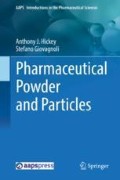Abstract
The foregoing sections described the methods of manufacturing and characterization of pharmaceutical particulate systems. Scrutiny of these systems defines key physicochemical properties establishing their quality as a preliminary to inclusion in a dosage form. This is fundamental to monitoring and control of critical properties of these systems with a view to optimization and establishing quality by design. The use of statistical experimental design during optimization and statistical process control during manufacturing allows the production of the dosage form to meet the target product profile within narrow limits that assure its uniformity. Ultimately, assuring the quality translates into a safe and efficacious drug product.
Access this chapter
Tax calculation will be finalised at checkout
Purchases are for personal use only
References
Mullin J. Crystallization. 3rd ed. Oxford, UK: Butterworth-Heinemann; 1993.
Parrott E. Milling of pharmaceutical solids. J Pharm Sci. 1974;63:813–29.
Masters K. Spray drying handbook. 5th ed. New York: Wiley; 1991.
Vehring R. Pharmaceutical particle engineering via spray drying. Pharm Res. 2008;25:999–1022.
Guckenberger D, deGroot T, Wan A, Beebe D, Young E. Micromilling: a method for ultra-rapid prototyping of plastic microfluidic devices. Lab Chip. 2015;15:2364–78.
Hickey A, Ganderton D. Pharmaceutical process engineering. New York: Informa Healthcare; 2010.
Kottke M, Rudnic E. Tablet dosage forms. In: Banker G, Rhodes C, editors. Modern pharmaceutics. 4th ed. New York: Marcel Dekker; 2002. p. 437–511.
Yu L. Pharmaceutical quality by design. Product and process development, understanding and control. Pharm Res. 2008;25:781–91.
Anderson T. An Introduction to multivariate statistical analysis. New York: Wiley; 1958.
Cochran W, Cox G. Experimental designs. New York: Wiley; 1957.
Taylor J. Statistical techniques for data analysis. Boca Raton: CRC Press; 1990.
Yu L, Amidon G, Khan M, Hong S, Polli J, Raju G, et al. Understanding pharmaceutical quality by design. AAPS J. 2014;16:771–83.
Box G, Hunter W, Hunter J. Statistics for experimenters. An introduction to design, data analysis and model building. New York: Wiley; 1978.
Oakland J, Followell R. Statistical process control. 2nd ed. Oxford, UK: Heinnemann Newnes; 1990.
Kourti T. The process analytical technology initiative and multivariate process analysis, monitoring and control. Anal Bioanal Chem. 2006;384:1043–8.
Mohammed A, Sunkari P, PSrinivas RA. Quality by design in action 1. Controlling critical quality attributes of an active pharmaceutical ingredient. Org Process Res Dev. 2015;19:1634–44.
Ilie G, Ciocoiu C. Application of fishbone diagram to determine the risk of an event with multiple causes. Manag Res Pract. 2010;2:1–20.
Liliana L. A new model of Ishikawa diagram for quality assessment. IOP Conf Ser: Mater Sci Eng. 2016;161:012099.
Lionberger R, Lee S, Lee L, Raw A, Yu L. Quality by design concepts for ANDAs. AAPS J. 2008;10:268–76.
Cairoli R, Dalang R. Sequential stochastic optimization. New York: Wiley; 1996.
Lee C. Fuzzy logic in control systems: fuzzy logic controller, Part II. IEEE Trans Syst Man Cybern. 1990;20:419–35.
Yen J, Langari R. Fuzzy Logic: intelligence, control and information. Upper Saddle River: Prentice-Hall; 1998.
Author information
Authors and Affiliations
Rights and permissions
Copyright information
© 2018 American Association of Pharmaceutical Scientists
About this chapter
Cite this chapter
Hickey, A.J., Giovagnoli, S. (2018). Quality by Design for Particulate Systems. In: Pharmaceutical Powder and Particles. AAPS Introductions in the Pharmaceutical Sciences. Springer, Cham. https://doi.org/10.1007/978-3-319-91220-2_11
Download citation
DOI: https://doi.org/10.1007/978-3-319-91220-2_11
Published:
Publisher Name: Springer, Cham
Print ISBN: 978-3-319-91219-6
Online ISBN: 978-3-319-91220-2
eBook Packages: Biomedical and Life SciencesBiomedical and Life Sciences (R0)

